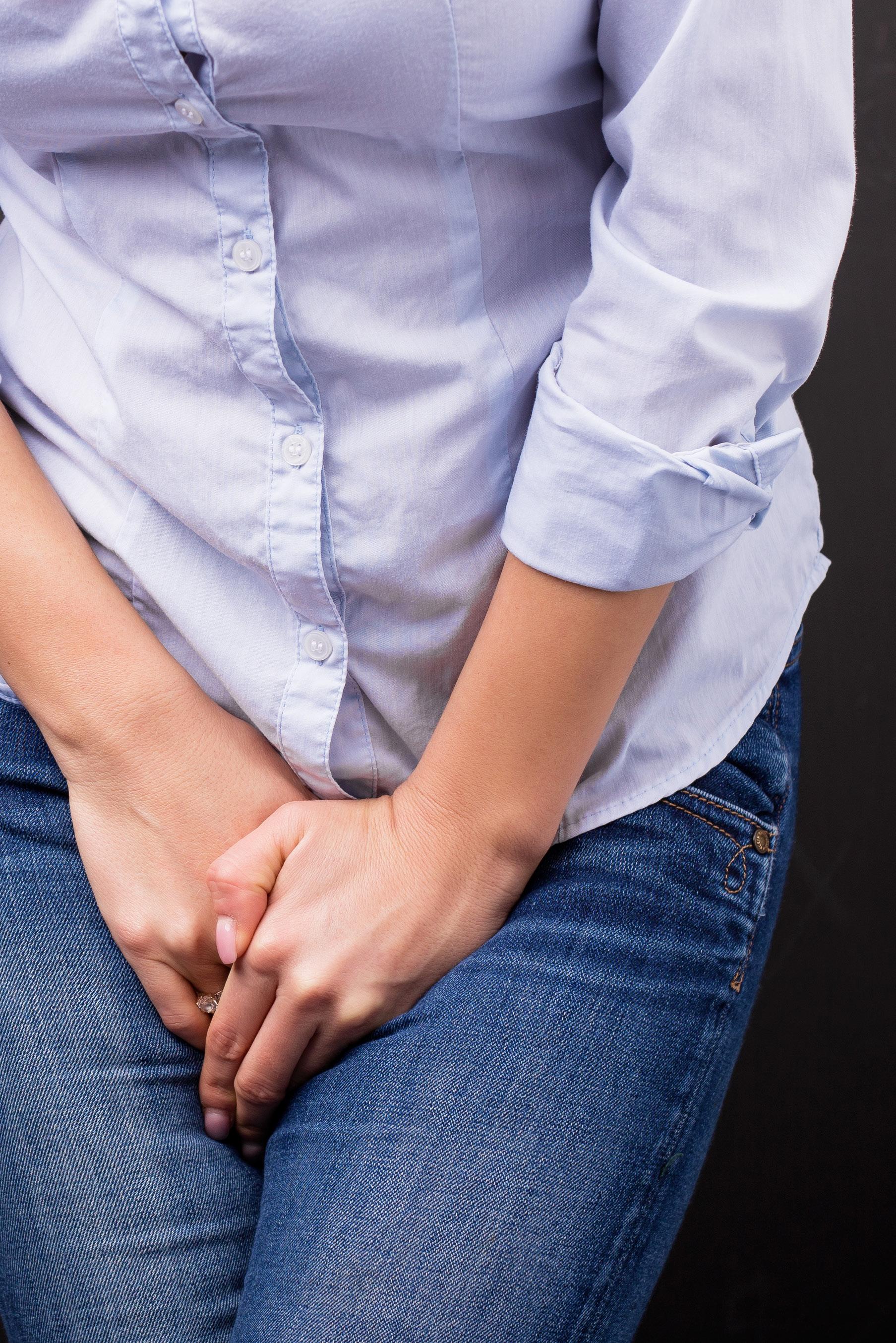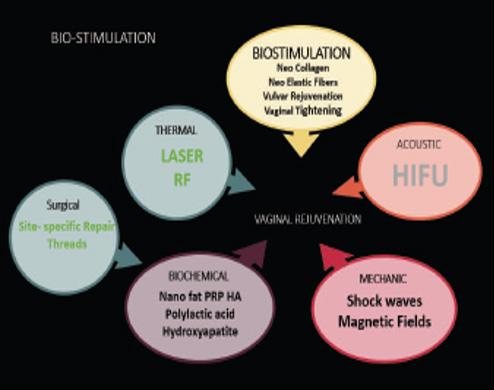
13 minute read
REGENERATIVE TREATMENTS FOR THE MENOPAUSE
There are few certainties in life but one is that all women will at some point go through the menopause. The only variable is when this happens and the degree to which it affects us. It is only recently that there has been an open discussion on menopause and its treatment, with regular articles and TV shows discussing symptoms and treatment. In 2022, the number of prescriptions for HRT had doubled, from five years previously, mainly due to increased awareness and the willingness to now talk about it. With increased awareness has come an increase in research into treatments for menopause and the symptoms associated with it.
One symptom that has become the focus of research is the Genito Urinary Syndrome of Menopause (GSM). This is also called post-menopausal vaginal atrophy. The number of articles being published in the medical press has increased significantly, and the awareness generally has increased consultations and referrals to health care practitioners.
GSM is a very technical definition for serious and debilitating symptoms that can affect more than 50%-70% of women who have gone through menopause. To some extent. Everyone accepts a degree of change as they age, but historically, GSM has been undiagnosed and rarely treated.
Signs and symptoms of GSM
Genital
Vaginal dryness
• Irritation/burning/itching
• Leukorrhea
• Thinning/graying pubic hair
• Vaginal/pelvic pain and pressure
• Vaginal vault prolapse
Sexual
• Dyspareunia
• Reduced lubrication
• Post-coital bleeding
• Decreased arousal, orgasm, desire
• Loss of libido, arousal
• Dysorgasmia
Urinary
Dysuria
Urgency
Stress/urgency incontinence
Recurrent urinary tract infections
Urethral prolapse
Ischemia of vesical trigone
Women suffer to different degrees and not all will have the full symptoms. Vaginal dryness is the main symptom, with over 90% of women who have gone through menopause suffering from this symptom. The obvious treatment for this is to put oestrogen back into the body and or directly into the vaginal lining of the mucosa. This can be done via HRT, but up until recently, the mainstay of treatment for GSM has been locally applied oestrogen.
This appears to be effective, but not all patients can have oestrogen and also there are some side effects associated with local oestrogen such as uterine bleeding, breast pain, perineal pain, and endometrial overstimulation.

The cause of these symptoms is a decrease and then a lack of oestrogen. This causes the vaginal lining to ‘atrophy’, which can be seen clearly in biopsies as an irregular collagen and fibrin pattern.
In the UK, local oestrogen treatments can be bought directly over the counter from pharmacists, but as well as increase in awareness of the condition and symptoms associated with GSM, there is also now an increased awareness of the available treatments. The majority of these new treatments have become available through the private sector as the NHS still does not allow a lot of the treatments to be available through FP10 prescription or recommendations.

There are four types of treatment to address the loss of connective tissue of the vaginal lining due to ageing: preventive, restitutive, curative and palliative.
Restitutive treatments are procedures aimed to restore normal function and metabolism to connective tissue. The most important restitutive treatment is bio-stimulation, which consists of a series of procedures that biologically activate fibroblast anabolic functions, and particularly enhance the production of type III collagen, elastin and hyaluronic acid from their precursors.
Bio-stimulation is not the same as biorestructuration, which is the variation of the components of the affected derma to achieve aesthetic improvement, albeit while damaging the physiology of the connective tissue. Many stimuli can promote bio-stimulation and, as a consequence, elastin fibres, collagen formation, and re-organisation of ground matrix, including thermal, biochemical, magnetic, ultra-sonic, and pulsed electrical fields. Of these, the most studied has been the thermal effect of a carbon dioxide laser applied intravaginally, which produces improvements in vaginal health following collagen and ground matrix remodelling due to the induction of heat shock proteins. The most important pathway for events leading to vaginal epithelial proliferation is the induction of growth factors.
Most of the new treatments for GSM symptoms occur outside the NHS. This is mainly due to the variability of the available data. For example, CO2 laser treatment, in various reviews, showed a similar symptomatic relief as local oestrogen, but without some of the side effects that are seen with oestrogen treatment. Recent data, though, suggests that there is no long-term benefit from the use of lasers as the long-term outcome is no different than no treatment. This is mainly due to a lack of follow up for the treatments and cost associated with the treatments.
For some patients, treatment of vaginal dryness is sufficient for symptomatic relief. There are many vaginal moisturisers available, and it is in fact one of the biggest categories on Amazon. This is sufficient for those lucky patients who do not need further treatment. The reality is that the symptoms will progress and get worse as patients age. At some point, for the majority of women, there will be the need for further intervention and yet the choices of treatment are limited by availability (ie not available on prescription), cost or, most commonly, a lack of awareness of available treatments for these debilitating symptoms.
There are now many treatments available in the private sector for the treatment of GSM and its symptoms, but awareness continues to be low and cost continues to be high. Truly effective treatments require a large capital investment by the clinic or healthcare practitioner which is reflected In high prices to the patient. The conundrum therefore for patients and healthcare professionals wishing to provide the best treatments to the majority of people is, firstly increasing awareness of the availability of treatments and secondly, having proven treatments that can be affordable and thus bring new patients into the clinic.
Recent studies have shown that there is a potential solution to this dilemma with the evolution of proven regenerative treatments for GSM and its symptoms. A study was published recently that demonstrated that the use of single growth factors have an effect on the vaginal mucosa. This study and others have shown that it is possible to treat the vaginal mucosa and thus improve symptoms by understanding the signalling process of the body and, in particular, of the regenerative process necessary to improve the atrophy of the vaginal lining when the patient has gone through menopause.
The use of growth factors, for the treatment of aesthetic conditions, has been evolving over the last 10 years. The full potential has never really been realised due to variability of results. The main issue is that the growth factors extracted from a human source and manufactured using human materials, has varying concentrations of grow factors and different types of growth factors for every extraction. In addition the expense and cost of this extraction and manufacturing has limited the use of growth factors.
Many of these issues have now been overcome by the use of technology that, when first developed won a Nobel prize in chemistry. The use of human recombinant growth factors, that are extracted and bioengineered to produce the growth factors that the body recognises and can be used a signalling molecule, allows a focussed and targeted approach to the improvement of the relevant condition.

Growth factors are signalling molecules that stimulate cells to produce other cells. In wound healing, this is proteins such as collagen and fibrin that start the wound healing process. The specific growth factors that are involved in this process can be bio-engineered and put into treatments for various conditions. The specific growth factors that are used in the regeneration of the vaginal mucosa have been developed and studied to evaluate the potential improvement in GSM symptoms.
The growth factor based gel (SkinGenuity VR), was evaluated initially to measure the effectiveness in the symptomatic relief using quantitative and qualitative analysis.
The first step was to trail the product in patients to see if the growth factor based gel could provide symptomatic relief for the patients suffering with GSM. The initial study has shown real promise for the gel with a significant improvement in the symptomatic relief using standard indices, that is comparable with laser therapy.
In addition biopsies were taken throughout the process to see if there was a significant improvement in the histology of the vaginal mucosa. The data clearly showed that there was a normalisation of the collagen.




The overall conclusion of the study is that the “results with the application of topical growth factors suggest that this treatment is safe and tolerable and can offer patients an important means to counteract vaginal atrophy in GSM.”
Further use of the product worldwide has backed up this conclusion, with SkinGenuity VR, now one of the mainstays of treatment for symptomatic relief for debilitating postmenopausal vaginal atrophy.
Further studies are, of course, being completed into the use of Growth Factors and GSM. Better treatments can be developed as we understand the cause and pathogenesis of GSM. The most frequent symptoms are related to vaginal dryness and dyspareunia; traditional treatments such as vaginal moisturisers fail to address improvement and relief of symptoms, indeed can become bothersome due to hyperosmotic properties of most of these types of compounds available in the market . Genital and urological complications such as urinary infections and vaginitis are related to ph alkalinisation that leads to the replacement of normal vaginal microbiota by pathogenic anaerobic bacteria. The ovulatory cycle influences vaginal microbiota, according to the action of estrogen and progesterone on the vaginal
To epithelium, due to an increase in thickness and glycogen production.
Lactobacillus population alteration is common in 50% of post-menopausal women with higher serum levels of folliclestimulating hormone and lower estrogen levels .
Available treatments are targeted to improve dryness and dyspareunia, but few reports on the management of vaginal microbiota dysbiosis are available in the scientific literature, mainly because there is a poor understanding of the pathophysiological scenario of a healthy vaginal environment.
Normalisation of the Ph and the vaginal microbiota could leave to a long term solution to the treatment of GSM without the requirement for hormonal or other physical interventions.
Overall, the awareness of menopause and hence the GSM symptoms has improved significantly over the last 10 years. People are willing to talk discuss symptoms such as painful sex, leakage and vaginal dryness. With this increased awareness has come an increased expectation that the symptoms that the majority of women suffer from, can now be treated. Unfortunately it is only in the private sector that treatment options and availability has increased. With an increase evidence base and more affordable, less invasive treatments there is the potential to now treat more patients who would otherwise suffer in silence. One such product is SkinGenuity VR and with an increase in evidence and awareness it offers a significant addition to the treatment protocols for symptomatic relief of GSM.
Resources
• Editorial, Menopause; A turning point for women’s health; Lancet VOLUME 10, ISSUE 6, P373, JUNE 2022
• Moral E, Delgado JL, Carmona F, et al ;Genitourinary syndrome of menopause. Prevalence and quality of life in Spanish postmenopausal women. The GENISSE study. Climacteric. 2018;21:167–173
Alexander Muacevic and John R Adler ; The Genitourinary Syndrome of Menopause: An Overview of the Recent Data; Cureus. 2020 Apr; 12(4): e7586; Published online 2020 Apr 8. doi: 10.7759/cureus.7586
J Suckling 1, A Lethaby, R Kennedy; Local oestrogen for vaginal atrophy in postmenopausal women; Cochrane Database Syst Rev 2006 Oct 18
Prignano F, Campolmi P, Bonan P, et al. Fractional CO2 laser: a novel therapeutic device upon photobiomodulation of tissue remodeling and cytokine pathway of tissue repair. Dermatol Ther 2009;22(Suppl 1):S8–15.
• Salvatore S, Leone Roberti Maggiore U, Athanasiou S, et al. Histological study on the effects of microablative fractional CO2 laser on atrophic vaginal tissue: an ex vivo study. Menopause 2015;22:845-9.
• Yeu-Chai Jang, MD, 1 Chi Yan Leung; Comparison of Severity of Genitourinary Syndrome of Menopause Symptoms After Carbon Dioxide Laser vs Vaginal Estrogen TherapyA Systematic Review and Meta-analysis; JAMA Netw Open. 2022 Sep; 5(9): e2232563.
• Chen R, Wang JY, Lv K. Effect of Fractional Carbon Dioxide Laser vs Sham Treatment on Vaginal Symptom Severity in Postmenopausal Women. JAMA. 2022;327(3):283. doi:10.1001/jama.2021.22305
• Simona Ceccarelli 1, Sirio D’Amici,;Topical KGF treatment as a therapeutic strategy for vaginal atrophy in a model of ovariectomized mice; J Cell Mol Med. 2014 Sep;18(9):1895-907.
• Raghvendra Vikram Tey, 1 Pallavi Haldankar; Variability in Platelet-Rich Plasma Preparations Used in Regenerative Medicine: A Comparative Analysis; Stem Cells Int. 2022; 2022: 3852898.
Stephan Barrientos 1, Olivera Stojadinovic; Growth factors and cytokines in wound healing; Wound Repair Regen;2008 SepOct;16(5):585-601.
Pablo González Isaza; Use of Growth Factors for Vulvo/Vaginal Bio-Stimulation;Technol Int 2019 May 15:34:269-273.
• Erekson EA. The Vulvovaginal Symptoms Questionnaire: a questionnaire for measuring vulvovaginal symptoms in postmenopausal women. Menopause. 2013 Sep;20(9):973-9.
• Management of symptomatic vulvovaginal atrophy: 2013 position statement of The North American Menopause Society. Menopause.2013;20(9):888–904.
• Gandhi J, Chen A, Dagur G, Suh Y, Smith N, Cali B, et al. Genitourinary syndrome of menopause: an overview of clinical manifestations, pathophysiology, etiology, evaluation, and management. Am J Obstet Gynecol. 2016;215(6):704–11
• Shen L, Zhang W, Yuan Y, Zhu W, Shang A. Vaginal microecological characteristics of women in different physiological and pathological period. Front Cell Infect Microbiol. 2022 Jul 22;12:959793.

Lorna Bowes is an experienced business owner, aesthetic nurse and trainer, having worked in aesthetics since the early 1990s. With extensive experience of delivering aesthetic procedures as well as an in-depth understanding of the global aesthetic medical market, she trains and lectures regularly on procedures and business management in aesthetics. Lorna specialises in cosmetic and medical skincare, treatments and peels. Lorna was a founding member of the British Association of Cosmetic Nurses and a Consulting Editor to the Journal of Aesthetic Medicine and she is the CEO of leading professional skincare distribution company, AestheticSource.
AestheticSource (www.aestheticsource.com) is the UK distributor of the awardwinning NeoStrata and Exuviance comprehensive ranges of clinically proven, dermatologist-developed skincare, peels and professional regimens featuring Hydroxy Acid technology, NeoGlucosamine and Apple Stem Cell Extract alongside other proven and powerful skincare ingredients to meet the needs of all skin types. AestheticSource have the expertise to provide you with world-renowned skin care products delivered in a timely manner, supported by bespoke marketing materials, a strong PR campaign, in-depth theory and practical training, post-training support, and friendly, helpful, knowledgeable staff to assist you.
Lorna loves leading the team, watching the ‘family’ develop, stretching their skills and working closely with the company’s customers and suppliers with a focus on trust, authenticity and passion, to support business growth for partner clinics in aesthetics and beauty.










